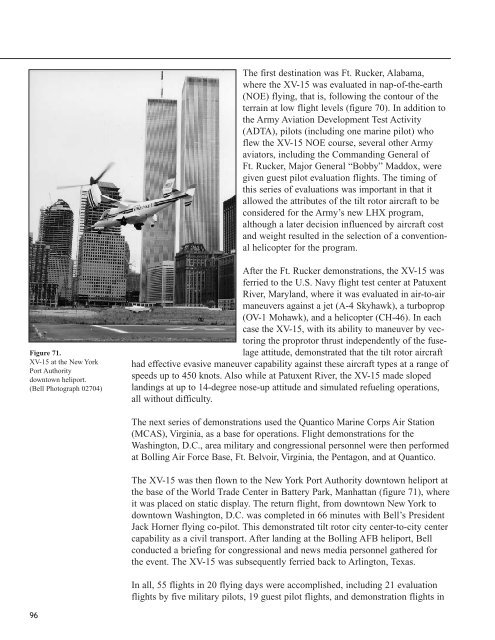XV-15 litho - NASA's History Office
XV-15 litho - NASA's History Office
XV-15 litho - NASA's History Office
Create successful ePaper yourself
Turn your PDF publications into a flip-book with our unique Google optimized e-Paper software.
Figure 71.<br />
<strong>XV</strong>-<strong>15</strong> at the New York<br />
Port Authority<br />
downtown heliport.<br />
(Bell Photograph 02704)<br />
96<br />
The first destination was Ft. Rucker, Alabama,<br />
where the <strong>XV</strong>-<strong>15</strong> was evaluated in nap-of-the-earth<br />
(NOE) flying, that is, following the contour of the<br />
terrain at low flight levels (figure 70). In addition to<br />
the Army Aviation Development Test Activity<br />
(ADTA), pilots (including one marine pilot) who<br />
flew the <strong>XV</strong>-<strong>15</strong> NOE course, several other Army<br />
aviators, including the Commanding General of<br />
Ft. Rucker, Major General “Bobby” Maddox, were<br />
given guest pilot evaluation flights. The timing of<br />
this series of evaluations was important in that it<br />
allowed the attributes of the tilt rotor aircraft to be<br />
considered for the Army’s new LHX program,<br />
although a later decision influenced by aircraft cost<br />
and weight resulted in the selection of a conventional<br />
helicopter for the program.<br />
After the Ft. Rucker demonstrations, the <strong>XV</strong>-<strong>15</strong> was<br />
ferried to the U.S. Navy flight test center at Patuxent<br />
River, Maryland, where it was evaluated in air-to-air<br />
maneuvers against a jet (A-4 Skyhawk), a turboprop<br />
(OV-1 Mohawk), and a helicopter (CH-46). In each<br />
case the <strong>XV</strong>-<strong>15</strong>, with its ability to maneuver by vectoring<br />
the proprotor thrust independently of the fuselage<br />
attitude, demonstrated that the tilt rotor aircraft<br />
had effective evasive maneuver capability against these aircraft types at a range of<br />
speeds up to 450 knots. Also while at Patuxent River, the <strong>XV</strong>-<strong>15</strong> made sloped<br />
landings at up to 14-degree nose-up attitude and simulated refueling operations,<br />
all without difficulty.<br />
The next series of demonstrations used the Quantico Marine Corps Air Station<br />
(MCAS), Virginia, as a base for operations. Flight demonstrations for the<br />
Washington, D.C., area military and congressional personnel were then performed<br />
at Bolling Air Force Base, Ft. Belvoir, Virginia, the Pentagon, and at Quantico.<br />
The <strong>XV</strong>-<strong>15</strong> was then flown to the New York Port Authority downtown heliport at<br />
the base of the World Trade Center in Battery Park, Manhattan (figure 71), where<br />
it was placed on static display. The return flight, from downtown New York to<br />
downtown Washington, D.C. was completed in 66 minutes with Bell’s President<br />
Jack Horner flying co-pilot. This demonstrated tilt rotor city center-to-city center<br />
capability as a civil transport. After landing at the Bolling AFB heliport, Bell<br />
conducted a briefing for congressional and news media personnel gathered for<br />
the event. The <strong>XV</strong>-<strong>15</strong> was subsequently ferried back to Arlington, Texas.<br />
In all, 55 flights in 20 flying days were accomplished, including 21 evaluation<br />
flights by five military pilots, 19 guest pilot flights, and demonstration flights in

















